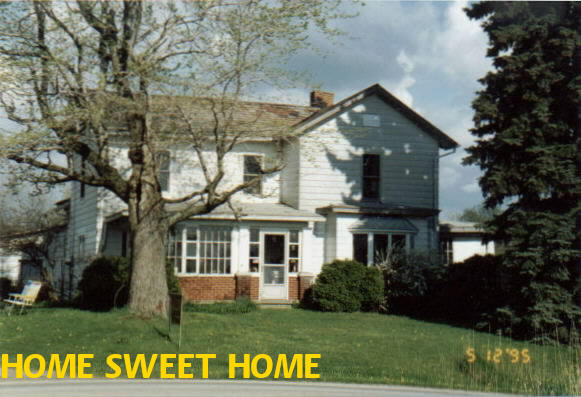 We live on Orchard Road near the haunt of one of the last Indians
known by name, Harthegig, to local white residents who have since died
in the past two or three generations. Stories are sparse but it is told
that he was seen quite regularly hiking up and down the stream
surviving on Nature and citizens' gifts. During construction of
Interstate Route 80, my neighbor Pete found a crude sandstone mortar
and a smooth conglomerate stone pestle near Harthegig's probable
campsite beside the run. It is reported that the Native American,
Harthegig, was murdered in 1797, and his spirit is said to haunt Hell's
Hollow, off of Route 62, two miles west of Mercer. His killers were
never found. An arrowhead found in my garden and a cent found beside
our house adds mystique to those who roamed this area so many years ago. We live on Orchard Road near the haunt of one of the last Indians
known by name, Harthegig, to local white residents who have since died
in the past two or three generations. Stories are sparse but it is told
that he was seen quite regularly hiking up and down the stream
surviving on Nature and citizens' gifts. During construction of
Interstate Route 80, my neighbor Pete found a crude sandstone mortar
and a smooth conglomerate stone pestle near Harthegig's probable
campsite beside the run. It is reported that the Native American,
Harthegig, was murdered in 1797, and his spirit is said to haunt Hell's
Hollow, off of Route 62, two miles west of Mercer. His killers were
never found. An arrowhead found in my garden and a cent found beside
our house adds mystique to those who roamed this area so many years ago.While the family was still living in Mercer, the Pews were intimately acquainted with the Indians living in the neighborhood. The latter frequently visited the frontier cabin and fondled the children. Among these Indians was the well known Harthegig, son-in-law of the old chief Petty. He was ugly in physical appearance, and his disposition partook of the characteristics of his body. He was addicted to the use of intoxicating drinks, and, when under the influence of the poison, was particularly quarrelsome and disagreeable. Then he was a terror to the children. On one occasion Harthegig, accompanied by two other Indians, Peter and John, came to the Pew cabin. Samuel, then a frolicsome boy, was sitting on one end of the logs that had been rolled into the huge, open throated fire-place, warming himself. Harthegig, the ugly Indian, approached him and seizing him by the hair, said: "I will scalp you." This language and the corresponding action so terrified the other Indians and James Jeffers, a neighbor who had accompanied them, that they all sprang to their feet and caught the drunken man, instantly disarming him. Then the three Indians left. Next morning Jeffers, who greatly disliked Harthegig, passed the Pew place, with his gun on his shoulder. Seeing young Samuel in the yard, he inquired whether Harthegig had passed up the hill that morning. Answered in the affirmative, Jeffers passed up through a skiff of snow which then covered the ground. Nothing of the Indian was subsequently seen, and his disappearance was enveloped in mystery. Nine years afterward a large skeleton of a human being was discovered near "Yankee Ridge," by a man named John Johnson. It was supposed to be the frame of the ugly and pugnacious Indian. The inference was that James Jeffers could have solved the mystery connected with the Indian's disappearance. From what source ???? |
Going back only to 1925, it was reported to us that the barn across the
road from our house was built of white pine in that year.
 Through
neglect, the barn could no longer fill its function. It was pulled down
about 1975. A fine oil painting of it, done by daughter Becky, hangs on our
den wall. Ah, but there is still a sturdy relic of 1925 across the road. It
was then that an ample red brick silo was built behind the barn. It's told
that the bricks were made in Volant, about nine miles southeast of here.
They were delivered to this farmstead over ice and snow during the winter by
sled. So there it still stands, companion to a sizable tree growing cozily
beside it. Through
neglect, the barn could no longer fill its function. It was pulled down
about 1975. A fine oil painting of it, done by daughter Becky, hangs on our
den wall. Ah, but there is still a sturdy relic of 1925 across the road. It
was then that an ample red brick silo was built behind the barn. It's told
that the bricks were made in Volant, about nine miles southeast of here.
They were delivered to this farmstead over ice and snow during the winter by
sled. So there it still stands, companion to a sizable tree growing cozily
beside it. |
|
|
|
|
 A month or so after moving into 'this old house' an older man stopped to talk to our kids who were out in the front yard. It was Mr. Ediburn, lately retired professor of a university in Kentucky or Tennessee. He explained that he had been born in this abode and had grown up here. His parting question was, "Is there still a leak in the living room ceiling?" He was assured by the kids that there sure was and they were right! The roof is fixed now. Let the rains come. |
 To challenge the rain may be machismo, but on the evening of May 31,
1985 our family was definitely out-trumped. After supper was over, a
look outside showed that the atmosphere presented to us a completely
alien look, something indefinite and indescribable. A rather
breathlessly still, green-gray miasma seemed to descend on the area.
Shortly. a spattering of hail arrived which we mistakenly took for the
cause of this rather strange condition. We looked to the west and soon
saw and heard a droning, truncated, wide cone of dark cloud material.
It was immediately and innately known to us as Menace.
Ninety-two-year-old Grandma, who could no longer navigate stairs, was
situated in the first-floor bathroom and given a flashlight as her only
solace. Wife and daughter headed down to the stone-walled cellar.
Father and son continued to monitor the approach of Menace from the
porch. The speed and direction of the funnel could not be gauged.
Never-the-less, we were convinced that we were indeed in the path of
destruction. With discretion in full bloom, the two men quickly joined
the women below. Here the four huddled together listening to the
static-filled music from Youngstown on the battery radio. After what
seemed like a long, long wait, but which hardly exceeded twenty
minutes, we warily climbed to the first floor. Looking outside, we saw
a sunny, blue-skied and inviting Springtime evening. Grandma was
retrieved and settled in her easy chair. The electric was off and would
continue to be for another four days. Eventually we learned that the
Menace had gone through about a mile to the north of our place. Sadly,
it had damaged or destroyed several homes in our vicinity and one
neighbor lady had been killed by a toppling chimney. Ironically, our
good Amish neighbors supplied us with windmill-lifted water and a
kerosene lamp for light. To challenge the rain may be machismo, but on the evening of May 31,
1985 our family was definitely out-trumped. After supper was over, a
look outside showed that the atmosphere presented to us a completely
alien look, something indefinite and indescribable. A rather
breathlessly still, green-gray miasma seemed to descend on the area.
Shortly. a spattering of hail arrived which we mistakenly took for the
cause of this rather strange condition. We looked to the west and soon
saw and heard a droning, truncated, wide cone of dark cloud material.
It was immediately and innately known to us as Menace.
Ninety-two-year-old Grandma, who could no longer navigate stairs, was
situated in the first-floor bathroom and given a flashlight as her only
solace. Wife and daughter headed down to the stone-walled cellar.
Father and son continued to monitor the approach of Menace from the
porch. The speed and direction of the funnel could not be gauged.
Never-the-less, we were convinced that we were indeed in the path of
destruction. With discretion in full bloom, the two men quickly joined
the women below. Here the four huddled together listening to the
static-filled music from Youngstown on the battery radio. After what
seemed like a long, long wait, but which hardly exceeded twenty
minutes, we warily climbed to the first floor. Looking outside, we saw
a sunny, blue-skied and inviting Springtime evening. Grandma was
retrieved and settled in her easy chair. The electric was off and would
continue to be for another four days. Eventually we learned that the
Menace had gone through about a mile to the north of our place. Sadly,
it had damaged or destroyed several homes in our vicinity and one
neighbor lady had been killed by a toppling chimney. Ironically, our
good Amish neighbors supplied us with windmill-lifted water and a
kerosene lamp for light. |
|
|
|
|
|
|
||
| home | next page | |
|
|
||